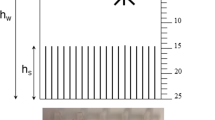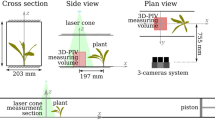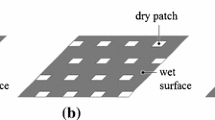Abstract
This study presents spatiotemporally-resolved measurements of surface shear-stress τ s in live plant canopies and rigid wooden cube arrays to identify the sheltering capability against sediment erosion of these different roughness elements. Live plants have highly irregular structures that can be extremely flexible and porous resulting in considerable changes to the drag and flow regimes relative to rigid imitations mainly used in other wind-tunnel studies. Mean velocity and kinematic Reynolds stress profiles show that well-developed natural boundary layers were generated above the 8 m long wind-tunnel test section covered with the roughness elements at four different roughness densities (λ = 0, 0.017, 0.08, 0.18). Speed-up around the cubes caused higher peak surface shear stress than in experiments with plants at all roughness densities, demonstrating the more effective sheltering ability of the plants. The sheltered areas in the lee of the plants are significantly narrower with higher surface shear stress than those found in the lee of the cubes, and are dependent on the wind speed due to the plants ability to streamline with the flow. This streamlining behaviour results in a decreasing sheltering effect at increasing wind speeds and in lower net turbulence production than in experiments with cubes. Turbulence intensity distributions suggest a suppression of horseshoe vortices in the plant case. Comparison of the surface shear-stress measurements with sediment erosion patterns shows that the fraction of time a threshold skin friction velocity is exceeded can be used to assess erosion of, and deposition on, that surface.
Similar content being viewed by others
Abbreviations
- A f :
-
Roughness element frontal area
- D :
-
Average roughness element diameter
- Q :
-
Mass transport rate
- Re h = U δ h/ν :
-
Roughness element Reynolds number
- S :
-
Ground area per roughness element
- U δ :
-
Free-stream velocity
- U s :
-
Wind speed at Irwin sensor-tube height
- c 1 and c 2 :
-
Constants
- d :
-
Sand grain diameter
- f = 20 kHz:
-
Hot-film sampling frequency
- f c :
-
Cut-off frequency
- h :
-
Roughness element height
- h s :
-
Irwin sensor tube height
- m :
-
Parameter relating \({\tau_{\rm s}^{\prime \prime}}\) to τ ′s
- Δp :
-
Pressure difference measured by Irwin sensor
- Δp′:
-
Fluctuations over pressure signal
- u :
-
Mean streamwise wind velocity
- u′:
-
Fluctuations in mean streamwise wind velocity
- \({u_\ast=(\tau/\rho)^{1/2}}\) :
-
Friction velocity
- u *t :
-
Fluid threshold friction velocity
- \({u_{\tau}=(\tau_{\rm s}/\rho)^{1/2}}\) :
-
Skin friction velocity
- u τ t :
-
Fluid threshold skin friction velocity
- \({\overline {{u}^{\prime}{w}^{\prime}}}\) :
-
Kinematic Reynolds stress
- w′:
-
Fluctuations in mean vertical wind velocity
- β c :
-
Irwin sensor calibration constant
- β :
-
Ratio of roughness element to surface drag coefficient
- λ :
-
Roughness density
- ν :
-
Kinematic viscosity of air
- \({\psi}\) :
-
Percentage of time that threshold skin friction velocity is exceeded
- ρ :
-
Air density
- σ :
-
Ratio of roughness element basal to frontal area
- σ u :
-
Standard deviation of wind speed U s
- \({\tau=\rho u_\ast^2 }\) :
-
Total shear stress averaged over whole canopy
- τ R :
-
Shear stress acting on roughness elements
- τ s(t, x, y):
-
Shear stress acting on surface
- \({\tau_{\rm s}^{\prime \prime}}\) :
-
Spatial peak of temporally-averaged surface shear-stress distribution
- τ s0 :
-
Spatiotemporally-averaged surface shear stress in the absence of roughness elements
- \({\xi}\) :
-
Normalized turbulence intensity
References
Anderson RS, Sorensen M (1991) A review of recent progress in our understanding of aeolian sediment transport. Acta Mech 1: 1–19
Bagnold R (1943) The physics of blown sand and desert dunes. Meghuen, London, 265 pp
Brown S, Nickling WG, Gillies JA (2008) A wind-tunnel examination of shear-stress partitioning for an assortment of surface roughness distributions. J Geophys Res 113: F02S06
Burri K (2011) Plants and mycorrhizal fungi on wind erosion control. Dissertation, ETH Zürich. doi:10.3929/ethz-a-006570793
Burri K, Gromke C, Graf F (2011a) Mycorrhizal fungi protect the soil from wind erosion: a wind-tunnel study. Land Degrad Dev. doi:10.1002/ldr.1136
Burri K, Gromke C, Lehning M, Graf F (2011b) Aeolian sediment transport over vegetation canopies: a wind-tunnel study with live plants. Aeolian Res 3: 205–213
Clifton A, Lehning M (2008) Improvement and validation of a snow saltation model using wind-tunnel measurements. Earth Surf Process Landf 33: 2156–2173
Crawley DM, Nickling WG (2003) Drag partition for regularly-arrayed rough surfaces. Boundary-Layer Meteorol 107: 445–468
Gillette DA, Stockton PH (1989) The effect of nonerodible particles on wind erosion of erodible surfaces. J Geophys Res 94: 12885–12893
Gillies JA, Nickling WG, King J (2002) Drag coefficient and plant form response to wind speed in three plant species: Burning Bush (Euonymus alatus), Colorado Blue Spruce (Picea pungens glauca), and Fountain Grass (Pennisetum setaceum). J Geophys Res. doi:10.1029/2001JD001259
Gillies JA, Nickling WG, King J (2007) Shear-stress partitioning in large patches of roughness in the atmospheric inertial sublayer. Boundary-Layer Meteorol 122: 367–396
Gromke C, Manes C, Walter B, Lehning M, Guala M (2011) Aerodynamic roughness length of fresh snow. Boundary-Layer Meteorol. doi:10.1007/s10546-011-9623-3
Irwin HPAH (1981) A simple omnidirectional sensor for wind-tunnel studies of pedestrian-level winds. J Wind Eng Ind Aerodyn 7: 219–239
Kim DS, Cho GH, White BR (2000) A wind-tunnel study of atmospheric boundary-layer flow over vegetated surfaces to suppress PM10 emission on Owens (dry) Lake. Boundary-Layer Meteorol 97: 309–329
King J, Nickling WG, Gillies JA (2006) Aeolian shear-stress ratio measurements within mesquite-dominated landscapes of the Chihuahuan Desert, New Mexico, USA. Geomorphology 82: 229–244
Lancaster N, Baas A (1998) Influence of vegetation cover on sand transport by wind: Field studies at Owens Lake, California. Earth Surf Proc Landf 23: 69–82
Lyles L, Allison BE (1975) Wind erosion: Uniformly spacing nonerodible elements eliminates effects of wind direction variability. J Soil Water Conserv 30: 225–226
Marshall JK (1971) Drag measurements in roughness arrays of varying density and distribution. Agric Meteorol 8: 269–292
Morris HM (1955) Flow in rough conduits. Am Soc Civil Eng 120: 373–398
Musick HB, Gillette DA (1990) Field evaluation of relationships between a vegetation structural parameter and sheltering against wind erosion. Land Deg Rehabil 2: 87–94
Musick HB, Trujillo SM, Truman CR (1996) Wind-tunnel modelling of the influence of vegetation structure on saltation threshold. Earth Surf Proc Landf 21: 589–605
Raupach MR (1992) Drag and drag partition on rough surfaces. Boundary-Layer Meteorol 60: 375–395
Raupach MR, Gillette DA, Leys JF (1993) The effect of roughness elements on wind erosion threshold. Geophys Res 98: 3023–3029
Schlichting H (1936) Experimental investigations of the problem of surface roughness. NASA Tech Memo 823 Washington
Shao Y (2008) Physics and modelling of wind erosion. Springer. ISBN:978-1-4020-8894-0, 452 pp
Sutton SLF, McKenna-Neumann C (2008) Variation in bed level shear-stress on surfaces sheltered by nonerodible roughness elements. J Geophys Res 113:F03016. doi:10.1029/2007JF000967
Valyrakis M, Diplas P, Dancey C, Greer K, Celik AO (2010) Role of instantaneous force magnitude and duration on particle entrainment. J Geophys Res. doi:10.1029/2008JF001247
Walter B, Gromke C, Lehning M (2009) The SLF Boundary Layer Wind-tunnel—An Experimental Facility for Aerodynamical Investigations of Living Plants. In: 2nd international conference “Wind effects on trees”, Freiburg, Germany, pp 31–37
Walter B, Gromke C, Leonard K, Clifton A, Lehning M (2011) Measurements of surface shear-stress distribution in live plant canopies. In: 13th international conference on wind engineering, Amsterdam, The Netherlands
Wolfe SA, Nickling WG (1996) Shear-stress partitioning in sparsely vegetated desert canopies. Earth Surf Proc Landf 21: 607–619
Wooding RA, Bradley EF, Marshall JK (1973) Drag due to regular arrays of roughness elements of varying geometry. Boundary-Layer Meteorol 5: 285–308
Wu H, Stathopoulos T. (1993) Further experiments on Irwin’s wind sensor. J Wind Eng Ind Aerodyn 53: 441–452
Wyatt VE, Nickling WG (1997) Drag and shear-stress partitioning in sparse desert creosote communities. Can J Earth Sci 34: 1486–1498
Author information
Authors and Affiliations
Corresponding author
Rights and permissions
About this article
Cite this article
Walter, B., Gromke, C., Leonard, K.C. et al. Spatio-Temporal Surface Shear-Stress Variability in Live Plant Canopies and Cube Arrays. Boundary-Layer Meteorol 143, 337–356 (2012). https://doi.org/10.1007/s10546-011-9690-5
Received:
Accepted:
Published:
Issue Date:
DOI: https://doi.org/10.1007/s10546-011-9690-5




